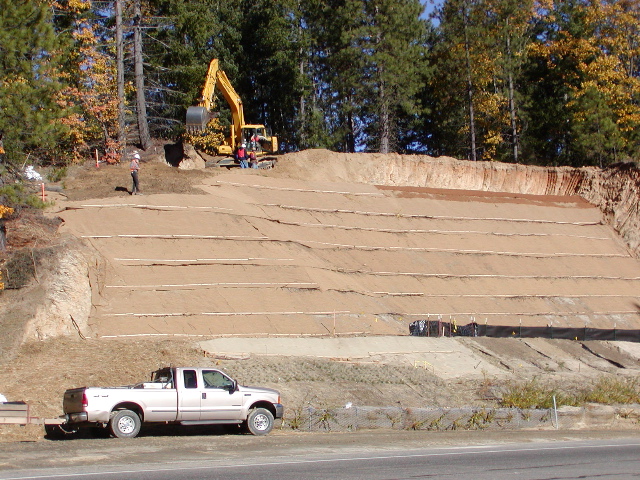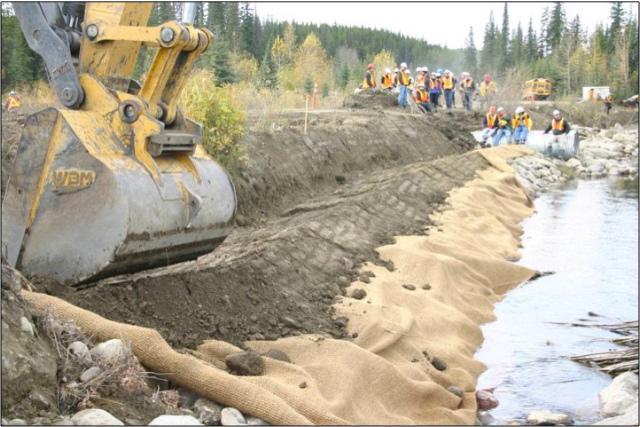17 Dec Workshop Sees Bioengineering
VMSE = Vegetated Mechanically Stabilized Earth
Donald Gray, Professor Emeritus Geotechnical Engineering, University of Michigan, my mentor and colleague defines biotechnical as “the combination of structural and biologic elements in a mutually beneficial manner”. In fact, Don help us research and author the NCHRP Report 544 – Environmentally-Sensitive Bank and Channel Stabilization Manual (AKA E-SenSS), which provides over 50 biotechnical or environmentally-sensitive techniques. I wanted my students to be suitably exposed to and knowledgeable of “Biotechnical Erosion Control” methods.

 As usual, one of the best ways to learn is by doing so my Shasta College Class, AGNR-66 Watershed Restoration Practicum, designed and built a biotechnical streambank stabilization project during the Stillwater Creek Workshop. We wanted to build a hands-on project that would showcase the College’s abilities. Brushlayering with willows (with or without geotextile inclusions) is, I believe, one of the most important bioengineering techniques – a technique that “is as old as dirt”, which utilizes/demonstrates the engineering principles of “reinforced earth”. Reinforced earth allows one to design/build stable slopes that can be steeper than the materials natural angle of repose. Another plus that I am finding is the reinforcement can replace a bit of the compaction that is usually applied. Plants prefer compaction in the 80%-90% range, so reinforced soil slopes can be a win win with regards to establishing vegetation. Contemporary reinforcements are provided by materials such as “geogrids” – very strong black polypropylene geotextiles (geogrids typically look like the temporary orange environmental fencing though manufactured with many strengthening properties. Well, “back in the day”, ancient China, Rome, and more recently Switzerland/Austria, the soil reinforcements were comprised of plant materials. Willow (Salix sp.) have played a long and successful role in soil reinforcement – imagine a geogrid that can grow and get stronger with time while providing immediate erosion control and environmental enhancements!!!
As usual, one of the best ways to learn is by doing so my Shasta College Class, AGNR-66 Watershed Restoration Practicum, designed and built a biotechnical streambank stabilization project during the Stillwater Creek Workshop. We wanted to build a hands-on project that would showcase the College’s abilities. Brushlayering with willows (with or without geotextile inclusions) is, I believe, one of the most important bioengineering techniques – a technique that “is as old as dirt”, which utilizes/demonstrates the engineering principles of “reinforced earth”. Reinforced earth allows one to design/build stable slopes that can be steeper than the materials natural angle of repose. Another plus that I am finding is the reinforcement can replace a bit of the compaction that is usually applied. Plants prefer compaction in the 80%-90% range, so reinforced soil slopes can be a win win with regards to establishing vegetation. Contemporary reinforcements are provided by materials such as “geogrids” – very strong black polypropylene geotextiles (geogrids typically look like the temporary orange environmental fencing though manufactured with many strengthening properties. Well, “back in the day”, ancient China, Rome, and more recently Switzerland/Austria, the soil reinforcements were comprised of plant materials. Willow (Salix sp.) have played a long and successful role in soil reinforcement – imagine a geogrid that can grow and get stronger with time while providing immediate erosion control and environmental enhancements!!!
 First thing for our project was to cut and store the willow branches. Brushlayering branches are generally 4′-8′ long. And there is numerous research efforts that indicate soaking willow will increase establishment. I could spend an entire blog giving up all the harvesting, handling, storing, selecting criteria for successful biotechnical construction but maybe later.
First thing for our project was to cut and store the willow branches. Brushlayering branches are generally 4′-8′ long. And there is numerous research efforts that indicate soaking willow will increase establishment. I could spend an entire blog giving up all the harvesting, handling, storing, selecting criteria for successful biotechnical construction but maybe later.
Just know it all exists in the Manuals on CD (BioDraw, ESenss, etc). see www.biodraw.com and www.esenss.com. Here my staff, Tara and Christine got to supervise all the willow harvesting. Talk about loving your work! It was nearly impossible to get them back into the office!
 When we soaked our bundles of branches, about 25 per bundle, we attracted some local bank beavers to ‘chow down’. They must have felt like somebody delivered pizza to their living room! Beaver cages are often used in Canada but I’ve never had to use one in CA before. Having some Enka mat TRM and orange fencing leftover, we improvised and ‘beaver-proofed’ our bundles!!
When we soaked our bundles of branches, about 25 per bundle, we attracted some local bank beavers to ‘chow down’. They must have felt like somebody delivered pizza to their living room! Beaver cages are often used in Canada but I’ve never had to use one in CA before. Having some Enka mat TRM and orange fencing leftover, we improvised and ‘beaver-proofed’ our bundles!!

 Bio Draw 1.0 and ESenSS (NCHRP Report 544) both give design/construction specs for VMSE – often referred to as “burrito wraps” or soil wraps. While they look good on paper, they are quite difficult to build, especially if there is insistence that the outer face of the wrap (lift) is “flat and planer”. The outer face is just too hard to pound or shape smooth before the wrap is made, go ahead, try to build a form or something, but trust me it takes a bit of time and many construction folks will baulk at the design. Note: the linear / flat face is not the most stable, according to Dr. Donald Gray. The outer geogrid will naturally form a more stable catenary curve shape. I refer to it as the “the wrap, when in x-section will look like a beer belly or pregnant tummy” so why fight nature and try to make it absolutely flat at exactly 1.5:1 for instance? Below are typical drawings for VMSE and flapping.
Bio Draw 1.0 and ESenSS (NCHRP Report 544) both give design/construction specs for VMSE – often referred to as “burrito wraps” or soil wraps. While they look good on paper, they are quite difficult to build, especially if there is insistence that the outer face of the wrap (lift) is “flat and planer”. The outer face is just too hard to pound or shape smooth before the wrap is made, go ahead, try to build a form or something, but trust me it takes a bit of time and many construction folks will baulk at the design. Note: the linear / flat face is not the most stable, according to Dr. Donald Gray. The outer geogrid will naturally form a more stable catenary curve shape. I refer to it as the “the wrap, when in x-section will look like a beer belly or pregnant tummy” so why fight nature and try to make it absolutely flat at exactly 1.5:1 for instance? Below are typical drawings for VMSE and flapping.

And then this dilemma of constructibility led us to the “Soil Flap Method” – very constructible and very effective. I must give credit to Chris Cummings, PE for Caltrans Dist 1. See our first project using flapping on Buckhorn Summit in the nasty decomposed granite (determined by many to be one of the most erosive soils anywhere – no clay, no cohesion, mucho silts and sands fractions!). Add some brushlayering and some heavy 9 g/m2 Coir netting and long/strong anchor pins or duckbills at the bottom of flap (the tightly-cinched belt below the beer belly) and this technique will give you geotechnical strength, reduced pore pressure (water will weep imperceptivqely and horizontally out the willow branches), and almost 100% effective erosion control (protection against raindrop impact) and sheet erosion (willow tips sticking out provide slope roughness) protection. This is the BOMB technique. And note, no compaction necessary on the face of the slope!! Note the still stable slope after 2 years This area receives over 40″-50″ rainfall and snow per winter.


 We couldn’t have done this project without the help of Bruce Lawson and his class. Bruce teaches Heavy Equipment Operations at the College, and he is one of the best dozer operators and human beings I know. Here is a picture of Tara giving Bruce her finger in his chest, all in jest. She broke her finger and it was splinted with wire and tape, We probably should have used a willow branch as the salicylic acid (yes, aspirin comes from willow!) may have relieved the pain.
We couldn’t have done this project without the help of Bruce Lawson and his class. Bruce teaches Heavy Equipment Operations at the College, and he is one of the best dozer operators and human beings I know. Here is a picture of Tara giving Bruce her finger in his chest, all in jest. She broke her finger and it was splinted with wire and tape, We probably should have used a willow branch as the salicylic acid (yes, aspirin comes from willow!) may have relieved the pain.
You can see Bruce operate at Prairie City OHV in this video:
Also I threw in some other photos of projects (Hinton Project) where we built VMSE. See the Dirt Time episodes on Streambank Stabilization, Hinton I and Hinton II.
 Next installment, after Christmas, I’ll cover some of the things we learned about Stillwater Creek, the evaluation of the old state-of-the-art streambank stabilization techniques (circa 1970) and how they (gabions and tires) are unraveling today, and more tips from David Derrick. Stay Tuned!
Next installment, after Christmas, I’ll cover some of the things we learned about Stillwater Creek, the evaluation of the old state-of-the-art streambank stabilization techniques (circa 1970) and how they (gabions and tires) are unraveling today, and more tips from David Derrick. Stay Tuned!
And you heard it here first, on Watchyourdirt.com
Comments ??? Please let us have it.
Merry Christmas!
John
